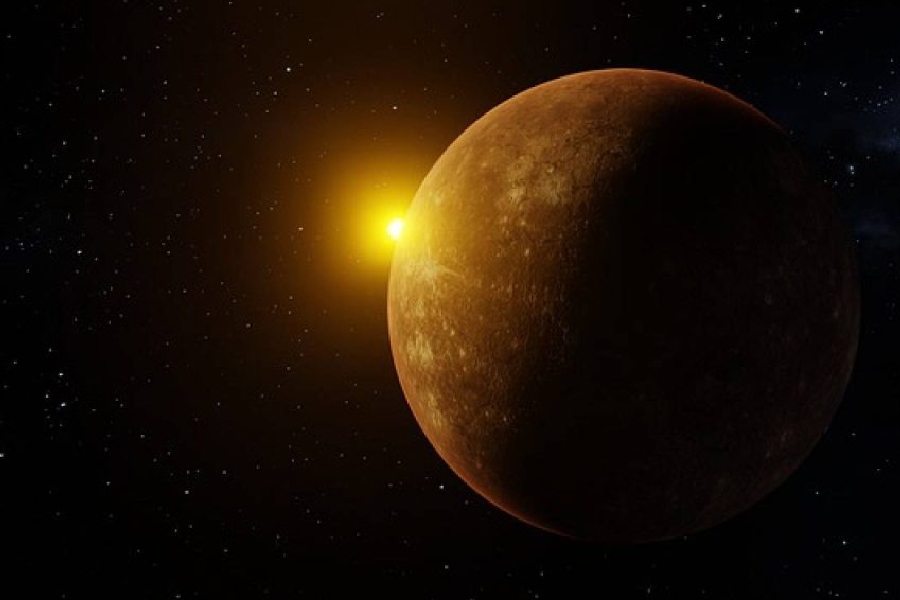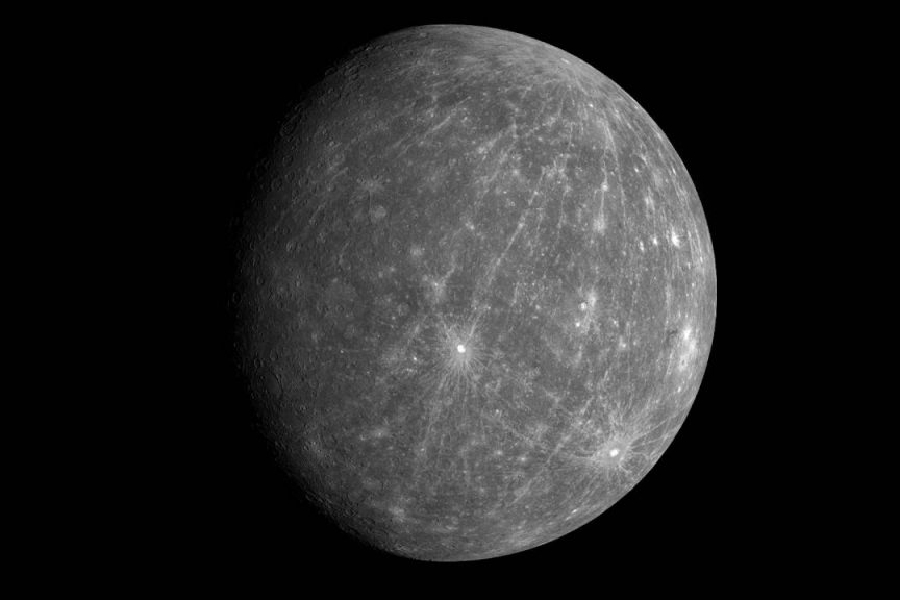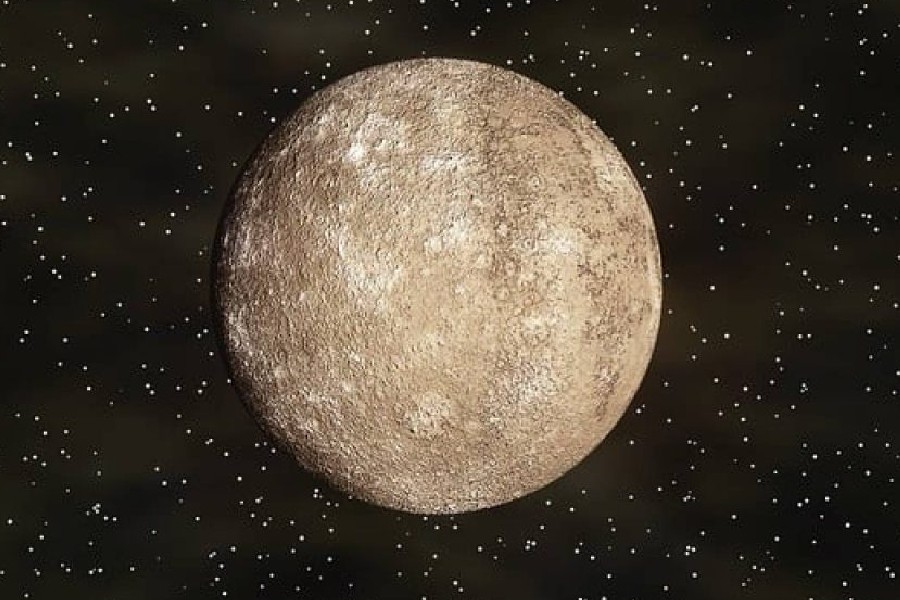Mercury, the smallest and innermost planet in our solar system, is a mysterious celestial object. The study of Mercury’s unique characteristics is not just an exercise in cosmic curiosity; it’s a crucial aspect of planetary science. These mercury characteristics offer a pick into the fundamental processes that govern the formation and evolution of planets.
Its starkly different environment, from its thin atmosphere to its heavily cratered surface, provides insights into the wider history of our solar system and the forces that have shaped celestial bodies.
So, continue reading to understand the distinct and alluring characteristics that define Mercury’s identity, exploring the planet’s place in the grand cosmic drama that unfolds above you.

Mercury Characteristics
Named after the Roman god of communication, it orbits the Sun at a mere 57.9 million kilometers (36 million miles), making it the closest planet to our star.
Despite its proximity, Mercury is a world of extremes, characterized by scorching days that reach temperatures of up to 430 °C (800 °F) and frigid nights that plummet to -180 °C (-290 °F).
Additionally, Mercury’s character as a rocky, terrestrial planet distinguishes it from the gas giants of our solar system. Its diminutive size, with a diameter of approximately 4,880 kilometers (3,032 miles), places it just above Pluto in terms of size.
Lack of atmosphere
One of Mercury’s defining characteristics is its near absence of an atmosphere. Its exosphere is incredibly thin and composed mainly of trace gases. This lack of a substantial atmosphere means that Mercury has no protective shield against the Sun‘s radiation, leading to extreme temperature fluctuations.
Surface composition
Mercury’s surface has intriguing features, marked by countless impact craters, extensive scarps, and volcanic plains. These surface characteristics provide valuable insights into the planet’s geological history and the processes that have shaped it over billions of years. The planet’s surface primarily comprises rock and metallic elements, contributing to its distinct appearance and unique character within the solar system.
Mercury Surface Features
Mercury’s surface is like a cosmic puzzle waiting to be solved. Here are the features that make up this planet:
Impact craters
Imagine Mercury’s surface as a target for space rocks. Over billions of years, countless meteoroids and asteroids have struck the planet, leaving behind scars known as impact craters. These craters come in all shapes and sizes, and some are incredibly deep. They tell the story of Mercury’s history, each impact leaving a mark that scientists study to understand the planet’s past.
Tectonic features
Mercury isn’t just a quiet planet; it’s had its fair share of rumbling and shifting. Tectonic features, like long cliffs called scarps, crisscross the surface. These scarps are like wrinkles in Mercury’s skin, formed as the planet cooled and shrank over time. They’re some of the longest cliffs in the entire solar system!
Plains and ridges
Mercury’s surface isn’t all craters and cliffs. It also has vast plains and intriguing ridges. The plains are like flat, open spaces, and the ridges are like rocky wrinkles. Scientists think these features may have formed from volcanic activity, giving Mercury a complex geological history.

Extreme Temperatures on Mercury
Mercury is a world of temperature extremes that challenge our understanding of what’s possible in our solar system. Let’s take a closer look at the scorching days and freezing nights on this remarkable planet:
Daytime heat
During Mercury’s daytime, temperatures soar to scorching heights. The planet becomes a celestial furnace thanks to its proximity to the Sun and its lack of a substantial atmosphere. Imagine standing on a surface where temperatures can reach a staggering 430 °C (800 °F). That’s hot enough to melt lead!
The reason for this extreme heat is the Sun’s relentless bombardment. Mercury sits so close to the Sun that it receives an intense dose of solar radiation. Without an atmosphere to trap heat or moderate temperature fluctuations, the surface bakes under unfiltered sunlight.
Nighttime cold
As the Sun sets on Mercury, the temperature plummets dramatically. With no atmosphere to retain heat, the planet rapidly loses warmth into the frigid void of space. Nighttime temperatures on Mercury can drop to a bone-chilling -180 °C (-290 °F). That’s colder than the coldest temperatures ever recorded on Earth!
Why are there extreme temperatures?
The extreme temperature swings on Mercury result from its unique characteristics. Its thin exosphere can’t retain heat, and its lack of a substantial atmosphere prevents temperature regulation. Additionally, Mercury’s slow rotation means it doesn’t distribute heat evenly across its surface.
Understanding these temperature extremes is not just an exercise of curiosity; it explains the broader processes of planetary climate and dynamics. These extremes also challenge our assumptions about habitability in the cosmos, reminding us that the conditions for life, as we know it, are scarce and delicate.
Orbital and Rotational Effects on Mercury
Mercury’s dance with the Sun is a celestial performance that results in some fascinating orbital and rotational effects.
Slow rotation
Mercury is known for its exceptionally slow rotation. While most planets in our solar system spin relatively quickly on their axes, Mercury takes its time. It completes a full rotation in about 59 Earth days. This leisurely pace means that a day on Mercury, from one sunrise to the next, is much longer than its year, a curious twist in the cosmic clockwork.
But why is Mercury such a slowpoke when it comes to spinning? It’s thought that intense gravitational interactions with the Sun over the eons have gradually caused it to lose rotational energy, slowing it down to its current speed. This slow rotation has intriguing consequences for the planet’s surface temperature and day-night cycle.
Tidal locking
Mercury’s slow rotation is not the only consequence of its close relationship with the Sun. The planet is also in a state of tidal locking. What this means is that as Mercury orbits the Sun, it keeps one face perpetually pointed towards our star. In other words, it’s as if one side of Mercury is in constant daylight while the other side remains shrouded in perpetual darkness.
Tidal locking results from gravitational forces between the planet and the Sun, causing Mercury’s rotation to synchronize with its orbit. This unique phenomenon creates extreme temperature contrasts between the lit and dark sides, with scorching heat on one and bitter cold on the other.
Geological Mysteries
Mercury’s surface is an ancient canvas that tells a story of its geological past. Here, we unravel two compelling mysteries that have puzzled scientists for years:
Evidence of past volcanic activity
Mercury’s surface is adorned with vast plains of solidified lava, known as “smooth plains.” These extensive volcanic plains suggest a history of volcanic activity that has reshaped the planet’s landscape. The presence of volcanic features like calderas and volcanic vents further supports this hypothesis.
However, the question that lingers is whether Mercury’s volcanic fires still burn beneath the surface. While some volcanic activity might have ceased billions of years ago, the planet’s scarred plains remain a testament to a volcanic history that has left an indelible mark.
Water ice at the poles
Imagine a scorching hot planet where surface temperatures can reach over 400 °C (800 °F). Now, picture water ice existing in such an extreme environment. This is precisely what scientists discovered at Mercury’s poles.
In regions permanently shadowed by the Sun’s fierce glare, there are pockets of water ice tucked away. These water-ice deposits have been a revelation, challenging our understanding of how such a hot and hostile world can harbor this essential component for life.
The source and history of this water ice remain subjects of intense research. Some theories suggest that it might have arrived on comets or been formed by chemical processes within Mercury’s thin exosphere.
These ice deposits not only provide insight into Mercury’s past but also raise questions about the broader distribution of water in our solar system.
Ongoing and Future Research
Space missions to Mercury
Our quest to uncover the mysteries of Mercury continues with dedicated space missions. Past missions like Mariner 10 and MESSENGER have provided crucial data, and ongoing missions like BepiColombo are expanding our understanding.
These missions involve sending spacecraft equipped with advanced instruments to study Mercury’s surface, atmosphere, and magnetic field, enabling us to collect detailed data and refine our knowledge of this intriguing planet.
Goals and objectives of upcoming missions
Upcoming missions to Mercury aim to address specific research goals. These objectives include investigating the planet’s magnetic field, studying its surface composition, and exploring its exosphere.
By probing these aspects, scientists hope to gain deeper insights into Mercury’s history, formation, and the processes that have shaped it over billions of years. These missions represent a crucial next step in unraveling the remaining mysteries of our solar system’s enigmatic messenger.
Frequently Asked Questions
What are three unique things about Mercury?
Mercury, the smallest planet in our solar system, boasts several distinct characteristics that set it apart. For example, the features are extreme temperatures, slow rotation, and tidal rotation.
Which characteristic is unique to Mercury?
The characteristic that is truly unique to Mercury is its extreme temperature variation. No other planet in our solar system experiences such drastic differences between daytime heat and nighttime cold as Mercury does.
Is Mercury the hottest planet in the solar system?
While it might seem intuitive that the planet closest to the Sun is the hottest, it’s not entirely accurate. Venus actually holds the title of the hottest planet in our solar system due to its thick carbon dioxide-rich atmosphere that traps heat, creating a scorching greenhouse effect.
Without a substantial atmosphere to retain heat, Mercury has the most extreme temperature fluctuations but doesn’t have the highest overall temperatures.

Conclusion
Mercury’s characteristics play an important role in advancing our knowledge of planetary science. As the closest rocky planet to the Sun, Mercury offers valuable insights into the fundamental processes that shape celestial bodies.
By exploring Mercury’s unique environment, including its thin atmosphere and heavily cratered surface, we gain a deeper understanding of the broader history of our solar system.
Overall, our exploration of Mercury’s characteristics holds profound implications for planetary science and our understanding of the universe. As we continue to delve into the mysteries of Mercury, we unlock the secrets of planetary evolution and cosmic dynamics, further illuminating the grand cosmic drama that unfolds above us.
